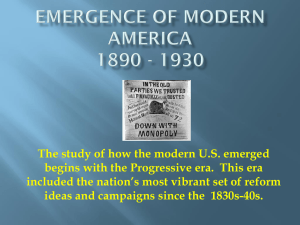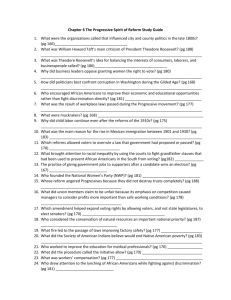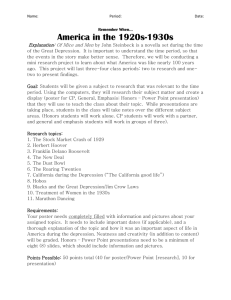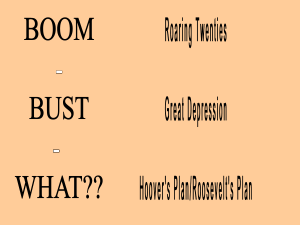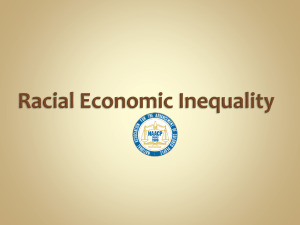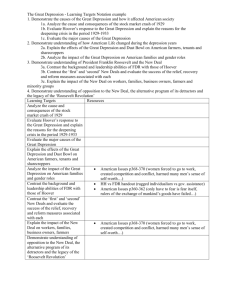Social Studies 8 Name Mr. Simone June 2015 Final Examination
advertisement
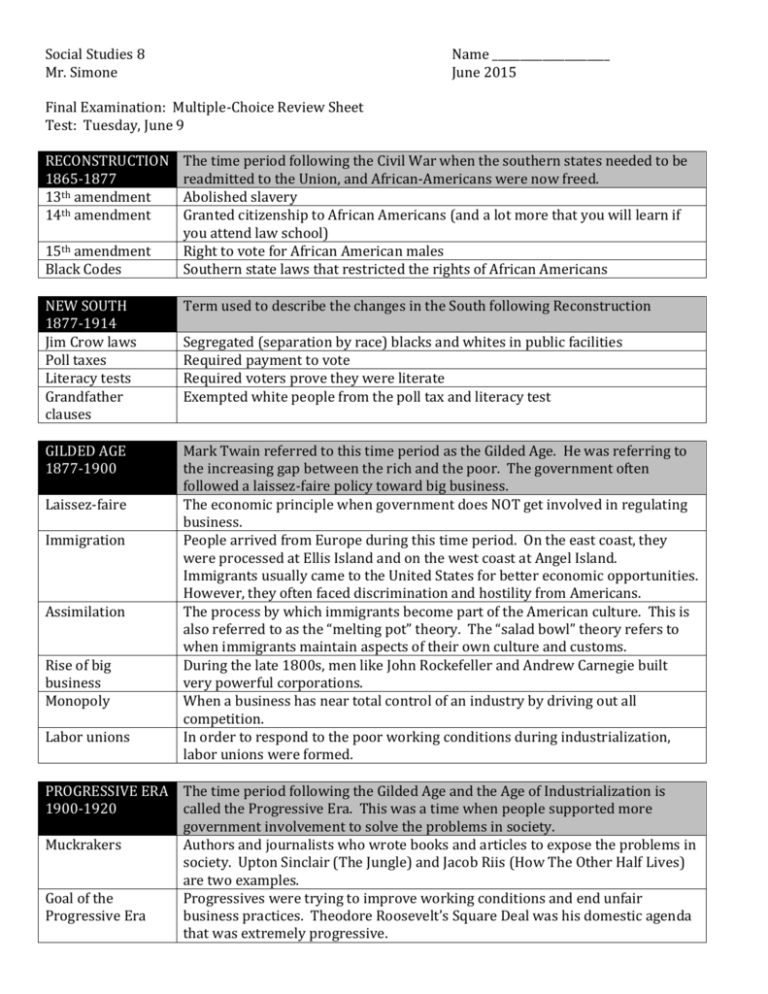
Social Studies 8 Mr. Simone Name _____________________ June 2015 Final Examination: Multiple-Choice Review Sheet Test: Tuesday, June 9 RECONSTRUCTION 1865-1877 13th amendment 14th amendment 15th amendment Black Codes The time period following the Civil War when the southern states needed to be readmitted to the Union, and African-Americans were now freed. Abolished slavery Granted citizenship to African Americans (and a lot more that you will learn if you attend law school) Right to vote for African American males Southern state laws that restricted the rights of African Americans NEW SOUTH 1877-1914 Jim Crow laws Poll taxes Literacy tests Grandfather clauses Term used to describe the changes in the South following Reconstruction GILDED AGE 1877-1900 Mark Twain referred to this time period as the Gilded Age. He was referring to the increasing gap between the rich and the poor. The government often followed a laissez-faire policy toward big business. The economic principle when government does NOT get involved in regulating business. People arrived from Europe during this time period. On the east coast, they were processed at Ellis Island and on the west coast at Angel Island. Immigrants usually came to the United States for better economic opportunities. However, they often faced discrimination and hostility from Americans. The process by which immigrants become part of the American culture. This is also referred to as the “melting pot” theory. The “salad bowl” theory refers to when immigrants maintain aspects of their own culture and customs. During the late 1800s, men like John Rockefeller and Andrew Carnegie built very powerful corporations. When a business has near total control of an industry by driving out all competition. In order to respond to the poor working conditions during industrialization, labor unions were formed. Laissez-faire Immigration Assimilation Rise of big business Monopoly Labor unions Segregated (separation by race) blacks and whites in public facilities Required payment to vote Required voters prove they were literate Exempted white people from the poll tax and literacy test PROGRESSIVE ERA The time period following the Gilded Age and the Age of Industrialization is 1900-1920 called the Progressive Era. This was a time when people supported more government involvement to solve the problems in society. Muckrakers Authors and journalists who wrote books and articles to expose the problems in society. Upton Sinclair (The Jungle) and Jacob Riis (How The Other Half Lives) are two examples. Goal of the Progressives were trying to improve working conditions and end unfair Progressive Era business practices. Theodore Roosevelt’s Square Deal was his domestic agenda that was extremely progressive. Suffrage Progressive Era Presidents Progressive legislation This is the right to vote. Women won suffrage rights with the 19th amendment. Theodore Roosevelt, William H. Taft and Woodrow Wilson IMPERIALISM 1867-1914 Reasons for U.S. imperialism Imperialism is when a stronger country takes over a weaker area of land. Causes of the Spanish-American War Results of the Spanish-American War Big Stick Policy WORLD WAR I 1914-1919 What was the policy of the U.S. at the beginning of the war? Why did the U.S. get involved in WWI? Pure Food and Drug Act Meat Inspection Act 1. 2. 3. 4. 1. 2. 3. 4. 5. Desire for new markets to sell goods Raw materials Uplift people overseas Gain power as a nation Humanitarianism – to help Cuba against Spain Economic interests - $50 million invested in Cuba Yellow journalism – newspapers were exaggerating the stories DeLome letter – Spain called President McKinley weak Sinking of the Maine – U.S. battleship sunk in Havana Harbor killing 262 Americans; “Remember the Maine” became our slogan (but Spain did NOT do it) The U.S. became an international power. Treaty of Paris – received Puerto Rico, Guam and the Philippines Received a military base in Cuba at Guantanamo Bay Theodore Roosevelt’s foreign policy following the Spanish-American War. He wanted the U.S. to become an international police force. It was an extension of the Monroe Doctrine (1823). The war started after Gavrilo Princip, a Serbian nationalism, assassinated Archduke Franz Ferdinand, heir to the Austro-Hungarian throne. The alliance system led to the conflict become worldwide. Neutrality Sinking of the Lusitania – British cruise ship, with Americans on board, was attacked by Germany Zimmerman Telegram – Germany sent a message to Mexico, trying to get them involved in the war (potentially against the U.S.) Treaty of Versailles Punished Germany severely and established the League of Nations Fourteen Points Woodrow Wilson’s plan for world peace Why did the U.S. The Senate rejected the treaty because it did not want to get involved in future NOT join the European conflicts. League of Nations? ROARING TWENTIES 1920-1929 Assembly line Flappers WERE THEY REALLY ROARING? There were various social changes during the decade. Used by Henry Ford to mass-produce automobiles, the Model T. Mass production helps to lower the cost of goods. Women who challenged traditional society by dressing and behaving differently during the decade. Immigration Quotas of the 1920s Economic conditions of the 1920s Red Scare The Immigration Acts of 1921 and 1924 were attempts to restrict the number of immigrants coming to the U.S. by using quotas. 1. more consumer goods 2. use of credit Fear of communists. GREAT DEPRESSION/NEW DEAL 1929-1941 When did the Great Depression begin? What is the definition of a depression? The Great Depression was the worst economic time in American history. FDR’s plan to solve the Great Depression was called the New Deal. Why did people blame Hoover for the Great Depression? He was president when the crash occurred. Some people blamed him for not doing enough to solve the economic problems. The term Hooverville referred to poor living conditions of people who lost their homes. Hoover flags and Hoover blankets were terms also used, demonstrating how many Americans blamed Hoover for their problems. New Deal The name of FDR’s programs to help put people back to work. He increased the role of government and did NOT follow a laissez-faire philosophy. WORLD WAR II 1939-1945 What happened on Dec. 7, 1941? How did U.S. involvement in WWII impact the economy? How did women contribute to the war effort during WWII? How did the government treat Japanese Americans during WWII? How did African Americans contribute to the On October 29, 1929, the Stock Market crashed. High unemployment and low demand for products The war began after Germany invaded Poland on Sept. 1, 1939 Japan attacked Pearl Harbor. It helped get the nation out of the Great Depression. Rosie the Riveter – women worked in the factories while men were fighting in Europe FDR’s Executive Order forced them into internment camps. The Supreme Court (Korematsu vs. United States) ruled that these camps were constitutional since the government needed to be concerned about national security. During the 1980s, the government apologized for this decision and paid survivors reparations. This is similar to how the government forced Native Americans to live on reservations. The Tuskegee Airmen were African American fighter pilots. war effort? What happened on Aug. 6, 1945? United Nations COLD WAR 1945-1991 Containment Marshall Plan Domino Theory NATO vs. Warsaw Pact McCarthyism Berlin Wall Bay of Pigs Invasion Cuban Missile Crisis CIVIL RIGHTS MOVEMENT President Harry Truman decided to drop an atomic bomb on Hiroshima, Japan. Three days later he ordered the atomic bomb on Nagasaki. He made this decision in order to bring an immediate end to the war. This world organization was also created to maintain world peace. But this time, the United States joined. The temporary headquarters were in Lake Success until construction in Manhattan was completed. The Cold War was an ideological struggle between the United States (capitalist and democratic) and the Soviet Union (communist and totalitarian). The Cold War began after World War II. The U.S. foreign policy during the Cold War to stop the spread of communism. The U.S. provided European nations with $12 billion in order to help them recover after World War II, and to prevent the spread of communism. The U.S. belief that if one country fell to communism, others would follow. The U.S. fought the Korean War and the Vietnam War (in Southeast Asia) in order to stop the spread of communism. The North Atlantic Treaty Organization was an alliance of countries loyal to the United States during the Cold War. The Warsaw Pact was an alliance of nations loyal to the Soviet Union. The purpose of NATO was to stop communist expansion. Senator Joseph McCarthy claimed to have a list of 205 Americans working in the government who were communist. He NEVER provided any names. The wall was built in 1961 dividing communist East Berlin from the free West Berlin in Germany. The failed U.S. attempt to overthrow Fidel Castro in Cuba. The U.S. prevented the Soviet Union from maintaining nuclear missiles in Cuba. The 1947 decision by the Brooklyn Dodgers to sign Jackie Robinson as the first African American to play in Major League Baseball is the symbolic beginning of the civil rights movement. To gain rights for African Americans What was the goal of the civil rights movement? Martin Luther King As a leader, he used civil disobedience (peaceful protest) to make progress. His Jr. “I Have A Dream” speech is one of the most famous of the civil rights movement.

